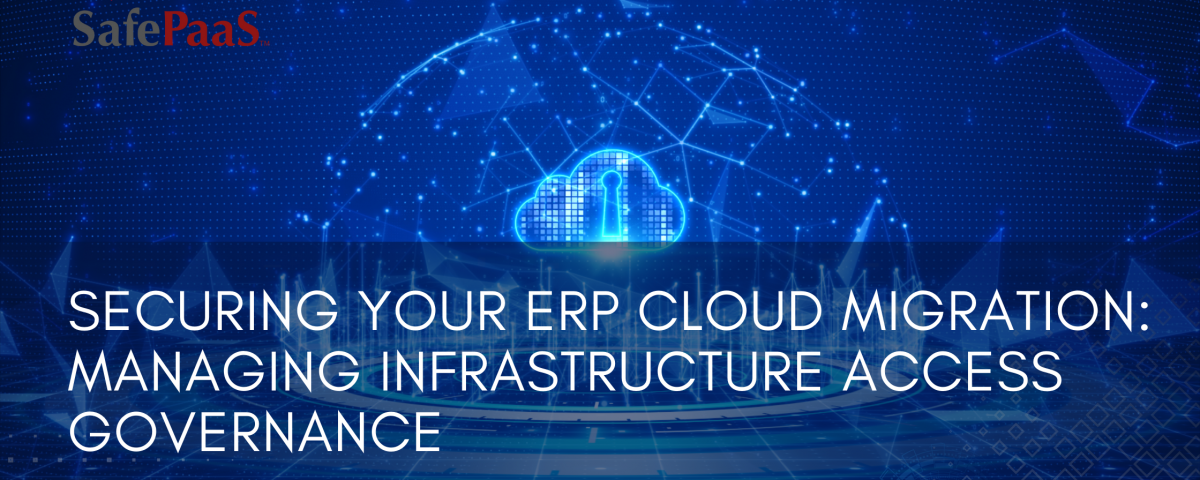Secure ERP Cloud Migration Infrastructure Access Governance


Securing Your ERP Cloud Migration:
Managing Infrastructure Access Governance
In today's constantly changing environment, remote work has become widespread, causing businesses to rely heavily on cloud hosting. They do so to improve scalability, cost efficiency, and adaptability. However, with the increasing adoption of cloud infrastructure, concerns about governance and security have also increased.
The growing prevalence of cyber threats in the cloud has brought discussions about cloud identities and identity certification to the forefront for enterprises. This heightened awareness comes from the realization that as the cloud expands exponentially - projected to store over 200 zettabytes of data and achieve a market size of $832.1 billion by 2025 - mitigating security risks and ensuring robust governance mechanisms are crucial.
Furthermore, the increased reliance on third-party service providers in cloud ecosystems adds another layer of complexity and concern. Collaboration with external entities demands strict measures to safeguard sensitive data and maintain compliance standards. Therefore, enterprises face the dual challenge of strengthening their cloud infrastructure against evolving cyber threats while ensuring third-party partners' trustworthiness and accountability in service delivery.
Essential Considerations for Cloud Migration
If you're looking to move your ERP applications from traditional on-premises setups to cloud platforms like Oracle Cloud Infrastructure (OCI), Amazon Web Services (AWS), and Microsoft Azure, it's crucial to have infrastructure access governance.
Most businesses know the need for application-level controls; however, protecting the database and operating systems level is also crucial. Application-level controls manage user permissions and access to specific software applications and functionalities. However, relying solely on these controls can leave security gaps, especially for highly privileged users with access to sensitive infrastructure-level data.
When your ERP applications are hosted, do you know what changes are being made to the database? Having infrastructure controls ensures you can also manage access to databases, operating systems, and network resources. Neglecting them can create vulnerabilities as privileged users may bypass application-level restrictions and access sensitive data or system resources.
Therefore, businesses must implement robust controls at the application and infrastructure levels. While application-level controls provide granular access management within specific software applications, infrastructure-level controls ensure that access to underlying resources is properly regulated and monitored.
Consequences of Inadequate Infrastructure Access Governance
- Manipulation of Financial Records: Users can modify financial data, like changing transaction amounts and account balances or creating fake entries to hide their tracks.
- Data Exfiltration: Users can steal sensitive data from databases or file systems, which can be used for identity theft, sold, or held for ransom.
- Disrupting Operations: Users can cause significant harm to businesses by damaging critical systems or infrastructure. This can result in downtime, loss of productivity, and financial losses.
- Installing Malware: Users deploy Malware onto systems to gain persistent access, steal data, or launch further attacks that can compromise system integrity and sensitive information.
- Identity Theft: Users can exploit vulnerabilities to steal credentials and gain unauthorized access to systems and data. They can masquerade as legitimate users for fraudulent activities or access restricted resources.
- Sabotage or Destruction: Users may aim to destroy critical data or infrastructure, which can cause irreparable damage and disrupt business operations.
- Privilege Escalation: Users can exploit security flaws to gain elevated access rights, which allow them to bypass security controls, manipulate data, or compromise other users' accounts.
Top 8 Key Capabilities to Look for in a Solution
1. Periodic Access Reviews: Periodic Access Reviews (PARs) are necessary for compliance with industry standards such as SOC2 and regulations like GDPR, especially in cloud environments. The increase in cyber threats has given rise to the need for PAR not only for systems such as ERP but also for databases and operating servers. These reviews ensure that users have appropriate access levels and help to reduce the risk of data breaches. PARs also provide audit-ready evidence of access controls, leading to smoother compliance audits and regulatory assessments.
2. Granular Database Monitoring: Ensure the solution offers comprehensive database monitoring capabilities, allowing you to track changes at the table, column, and program levels within your database. This granularity enables real-time detection of unauthorized access attempts and modifications to sensitive data structures.
3. Integration with Cloud Platforms: Look for a solution that seamlessly integrates with popular cloud platforms like Oracle Cloud Infrastructure (OCI), enabling you to extend your access governance practices to cloud-based applications and databases. This ensures consistent security measures across on-premise and cloud environments.
4. Real-time Incident Reporting: Choose a solution that provides immediate incident reporting capabilities, alerting IT security and compliance teams to potential security breaches or policy violations as they occur. Real-time reporting allows for swift corrective action, minimizing the impact of security incidents on your organization.
5. Compliance with Privacy Regulations: Ensure the solution helps you maintain compliance with global privacy regulations by enforcing strict access controls and preventing unauthorized data access. Look for features that support regulatory requirements such as GDPR, CCPA, and HIPAA to safeguard sensitive data and avoid costly fines.
6. Privileged User Monitoring: Opt for a solution with strong privileged user monitoring capabilities, allowing you to track and audit privileged user activity within your database environment. This helps prevent misuse of elevated privileges and ensures accountability among privileged users.
7. Data Analysis and Insights: Seek a solution that offers advanced data analysis capabilities, enabling decision-makers to derive actionable insights from access governance data. Features like data visualization tools and customizable reporting dashboards empower organizations to make informed decisions and drive strategic planning initiatives.
8. Scalability and Flexibility: Look for a solution that scales with your organization's growth and adapts to evolving access governance requirements. Choose a platform that offers flexibility in deployment options, allowing you to tailor the solution to your specific needs and integrate seamlessly with existing IT infrastructure.
When evaluating solutions, prioritize these key features to strengthen data security practices, maintain compliance, and mitigate the risk of security breaches and data leaks.
While the benefits of cloud hosting are undeniable, managing its complexities demands robust access governance. SafePaaS's Unified Privileged Access Governance solution addresses these challenges by enforcing strict access controls, ensuring least privilege, and offering scheduling capabilities for third-party access at the database level.
Learn how SafePaaS can help you enforce strict access governance over your applications and cloud infrastructure.
Recommended Resources

Control Third-party Access Risk
Your organization doesn't need another point solution to tackle third-party access risk; they may even complicate your troubles. If you're serious about locking down your third-party access risk, the best solution is a platform to manage all identities: employees, external users, IoT devices, and bots.

Getting Access Certification right
Many enterprises using an identity management tool believe this will suffice for access governance. However, an identity management tool is only a point solution - access governance is far more complex.

Definite Guide to Modern IAM
Integrating IGA, AM, and PAM creates a central hub of policy, governance, and enforcement of identity security. With an integrated policy-based approach, a privileged access request can be managed within the organization's IGA policies.

